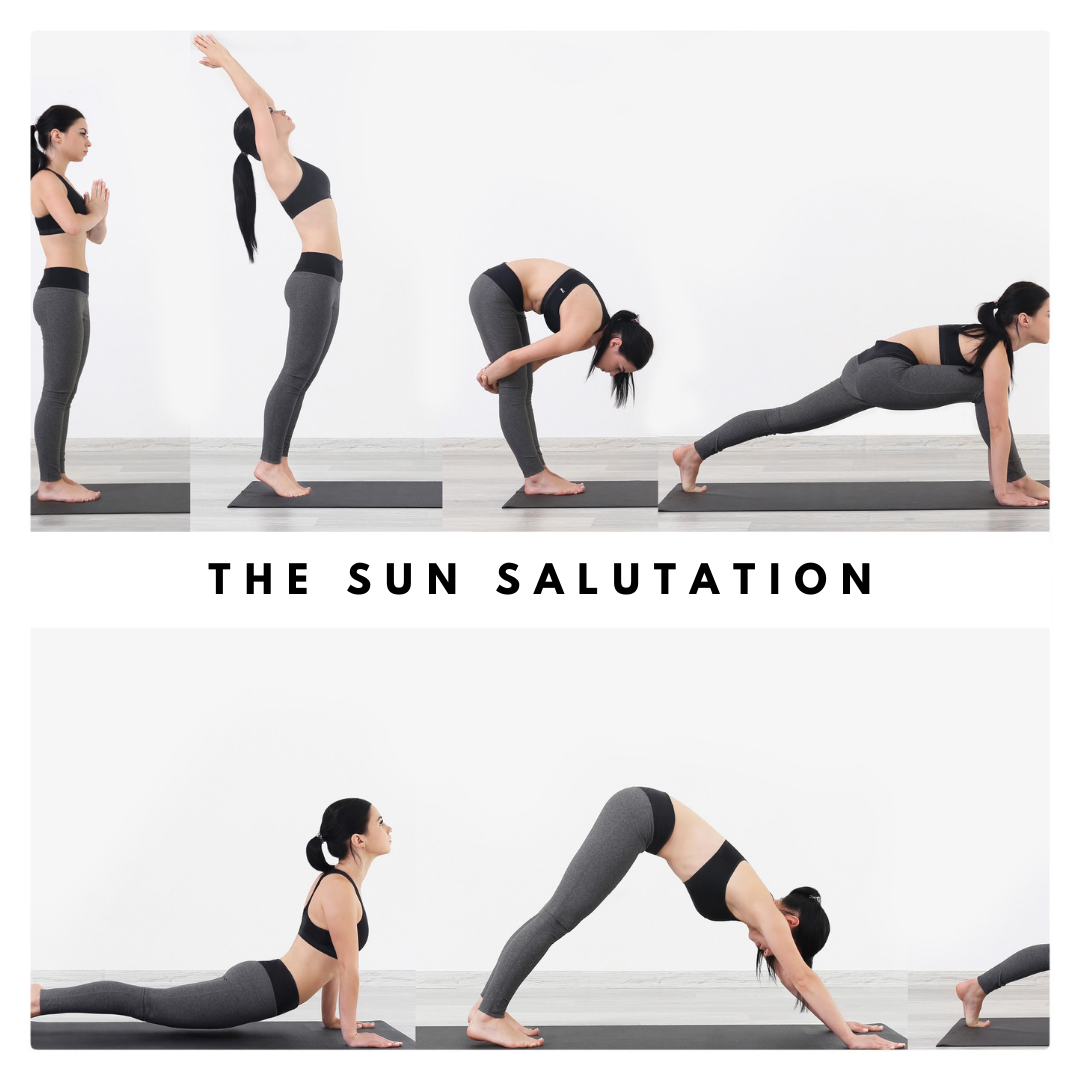The Sun Salutation
The Sun Salutation is one of the most practical ways of achieving a healthy and vigorous body, while preparing oneself for meditation and higher yogic practices.
The Sun Salutation or Surya Namaskara in Sanskrit is a valuable inheritance from the Vedic times. The sun symbolises consciousness, and in ancient times it was venerated by cultures worldwide
There are two types of energies in the body known as the vital energy or prana and the mental energy. Vital energy, governs physical activity, extroversion, vitality, logic, reasoning, etc. Mental energy governs introversion, empathy, creativity, etc. Both these energies must be balanced if we wish to experience overall health and wellbeing.
In yoga, the sun represents the solar channel or pingala nadi, the channel which distributes the vital force within the body. Sun salutations have a stimulating effect on the vital energy in the body and practicing them consistently helps regulate pingala nadi, ensuring a balanced energy system both in the body and the mind.
The sun salutation is an effective way of gaining flexibility and loosening the body as well as stretching, toning and massaging the joints, muscles and organs. It is one of the most practical ways of achieving a healthy and vigorous body, while preparing oneself for meditation and higher yogic practices.
The sun salutation is a complete yogic practice, as it includes asana, pranayama, mantra and requires maintaining constant awareness.
The ideal time to practice the sun salutation is at sunrise. If possible in the open air, facing the rising sun. Practicing at sunset is also suitable and is considered to improve digestive processes. Those who are unable to practice at these times, can do so at any time they wish, as long as they are done on an empty stomach.
The twelve asanas of Surya Namaskara:
1. Prayer Pose – Pranamasana
Stand straight with the feet together and the arms beside the body. Gently close your eyes. Become aware of the sun and think about its importance for all life on the planet for a few moments.
Slowly bend your elbows and bring the palms to the chest in namaskara mudra. Keep the body completely relaxed.
Intermediate yogi: After having practiced surya namaskara for a few days, you may fix your awareness on the chest area during Pranamasana.
Advanced yogi: Fix your awareness on Anahata chakra.
Adept yogi: Fix the awareness on Anahata chakra and repeat the mantra Om Mitraya Namaha, which means salutations to the friend of all.
2. Raised Arms pose – Hasta Utthanasana
Inhale and hold, whilst you stretch the arms above the head, keeping them shoulder width apart. Bend the head, arms and upper trunk slightly backward.
Intermediate yogi: Fix your awareness on the lungs and abdomen.
Advanced yogi: Fix your awareness on Vishuddhi Chakra.
Adept yogi: Fix the awareness on Vishuddhi chakra and repeat the mantra Om Ravaya Namaha, which means salutations to the shining one.
3. Standing forward bend – Padahastasana
Exhale and hold. Bend forward taking the fingers towards the floor right beside the feet. Bring the head as close as possible to the knees without strain, keeping the knees straight. Contract the abdomen as much as possible in the end position to expel any air left in the lungs.
Intermediate yogi: Fix your awareness on the pelvic region.
Advanced yogi: Fix your awareness on Swadhisthana chakra.
Adept yogi: Fix your awareness on Swadhisthana chakra and the mantra Om Suryaya Namah – salutations to one who fills us with vigour.
Note: If you have any back conditions, do not bend forward fully. Bend only as far as you comfortably can.
4. Equestrian pose – Ashwa Sanchalanasana
Inhale and place the hands flat beside the feet, whilst stretching the right leg as far back as possible. Bend the left knee, keeping the left foot on the floor in the exact same position. Ensure the arms are straight, and the weight of the body is distributed between the hands, left foot, right knee and the right foot toes. Slightly bend your head backwards and arch the back.
Intermediate yogi: Fix your awareness on the stretch.
Advanced yogi: Fix your awareness on the Ajna chakra.
Adept yogi: Fix your awareness on Ajna chakra and the mantra Om Bhanave Namaha – which means salutations to the one who illumines.
5. Stick Pose – Parvatasana
Exhale and take the left foot back beside the right foot. At the same time, raise the glutes and lower your head, bringing it between the arms. Keep the arms and legs completely straight. If possible, ensure the heels touch the floor, whilst bringing the head close to the knees, without straining.
Intermediate yogi: Fix your awareness on the throat region.
Advanced yogi: Fix your awareness on Vishuddhi chakra.
Adept yogi: Fix your awareness on Vishuddhi chakra and the mantra Om Khagaya Namaha, which means salutations to the one who moves rapidly in the sky.
6. Eight-part salute – Ashtanga Namaskara
Retain the breath outside, lowering the knees, chest and chin to the floor, which should be the only parts of the body touching the floor apart from the toes and hands. Keep the glutes, hips and abdomen raised.
Intermediate yogi: Fix your awareness on the abdominal area.
Advanced yogi: Fix your awareness on Manipura chakra.
Adept yogi: Fix your awareness on Manipura chakra and the mantra Om Pushne Namaha, which means salutations to the giver of the strength.
7. Cobra pose – Bhujangasana
Inhale and lower the glutes and hips towards the floor. Straighten the arms and arch the back whilst pushing the chest forward and coming into cobra pose. Arch the head backwards and gaze upward toward the eyebrow centre.
Intermediate yogi: Fix the awareness on the spine.
Advance yogi: Fix your awareness on Swadhisthana chakra.
Adept yogi: Fix your awareness on Swadhisthana chakra and the mantra Om Hiranya Garbhaya Namaha, which meanssalutations to the true self.
8. Downward facing dog – Parvatasana
Exhale and move back into parvatasana without moving the hands and feet.
Intermediate yogi: Fix your awareness on the throat region.
Advanced yogi: Fix your awareness on Vishuddhi chakra.
Adept yogi: Fix your awareness on Vishuddhi chakra and the mantra Om Marichaya Namaha, which means salutations to the Lord of the Dawn.
9. Equestrian pose – Ashwa Sanchalanasana
Inhale and come into Ashwa Sanchalanasana without moving the palms.
Intermediate yogi: Fix your awareness on the stretch.
Advanced yogi: Fix your awareness on the Ajna chakra.
Adept yogi: Fix your awareness on Ajna chakra and the mantra Om Adityaya Namaha – which means salutations to the son of Aditi, who is the universal feminine.
10. Standing forward bend– Padahastasana
Exhale and come back into Padahastasana.
Intermediate yogi: Fix your awareness on the pelvic region.
Advanced yogi: Fix your awareness on Swadhisthana chakra.
Adept yogi: Fix your awareness on Swadhisthana chakra and the mantra Om Savitre Namah, which means salutations to lord of creation.
11. Raised arms pose – Hasta Utthanasana
Inhale and come back to Hasta Utthanasana.
Intermediate yogi: Fix your awareness on the lungs and abdomen.
Advanced yogi: Fix your awareness on Vishuddhi Chakra.
Adept yogi: Fix the awareness on Vishuddhi chakra and repeat the mantra Om Arkaya Namaha, which means salutations to the who is fit to be praised.
12. Prayer pose – Pranamasana
Exhale and come back to the initial position, pranamasana.
Intermediate yogi: Fix your awareness on the chest area during Pranamasana.
Advanced yogi: Fix your awareness on Anahata chakra.
Adept yogi: Fix the awareness on Anahata chakra and repeat the mantra Om Bhaskaraya Namaha, which means salutations to the one which leads us to enlightenment.
Completing one round
The 12 asanas represent half a round of the sun salutation. They must be done once more with the other foot in ‘downward facing dog’ and ‘equestrian pose’ to complete one round.
In the beginning stages, it is best to lower the arms and let the breath come back to normal at the end of each half round.
Practice and duration:
Practice 3 to 12 rounds of the sun salutation slowly, building up progressively. It is best to start with 3 rounds and slowly build up by adding one round each week. Beginners should spend a few seconds on each asana, focusing on postural hygiene and deep stretching. Adepts can practice sun salutations dynamically.
Important notes:
If one experiences a rise in temperature, fever, rashes on the skin or any inflammation the practice should be discontinued at one. These are signs of overheating and excessive flushing of toxins.
Once the toxins have been flushed and all the symptoms have ceased, it is ok to restart the practice with a lower number of rounds, building up slowly with time.
The sun salutation should never be practiced by those with high blood pressure or those suffering from any cardiovascular disease.



